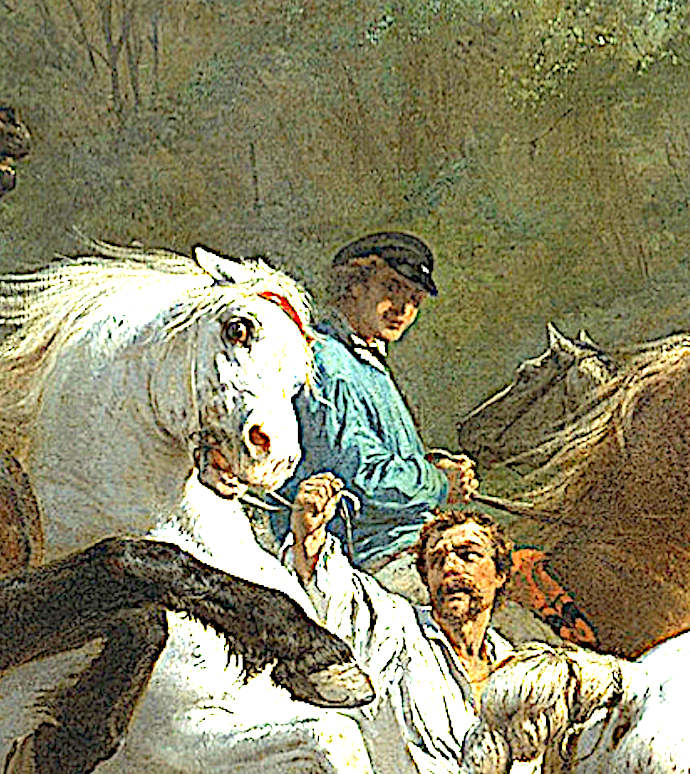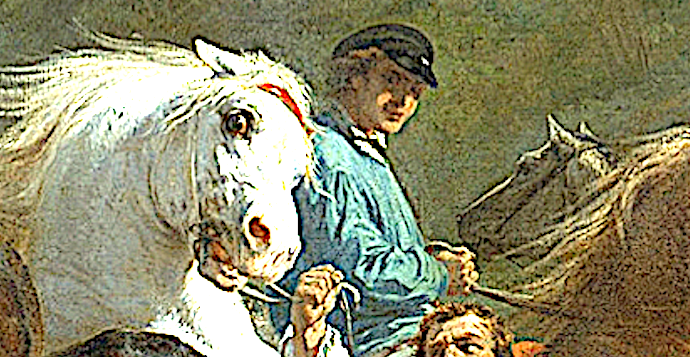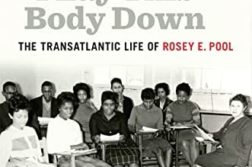THE FRENCH PAINTER Rosa Bonheur (1822-1899) is having a moment after a century of being largely forgotten. On the occasion of the bicentenary of her birth, the Musée d’Orsay in Paris organized a major retrospective of her artistic works, including 200 paintings, sculptures, and photographs that the artist produced at the end of the 19th century. The Musée des Beaux-Arts de Bordeaux and the Rosa Bonheur Museum contributed to this unparalleled exhibition (which closed on January 15th).
Specializing in dramatic, realist pictures of animals in rural settings, Bonheur’s art made her internationally famous and independently wealthy, and she was celebrated as the premier animal painter of her day (many believe of all time). At the height of her international fame in 1865, the French Empress Eugénie traveled to Bonheur’s residence, known as the Château de By (now the Rosa Bonheur Museum), some 34 miles southeast of Paris on the outskirts of the Fontainebleau Forest. She came to present the 43-year-old painter with the Légion d’honneur, France’s highest honor.
In the years that followed, however, a new generation of artists began to abandon the academic, realist style of painting that Bonheur epitomized. They painted their impressions of light, color, and modern life, and in the pro-cess they completely reimagined painting. Monet, Seurat, Van Gogh, Cézanne, and others created a new æsthetic that parted ways with traditional, hyper-realist representation. Bonheur’s work was viewed as passé. If she was mentioned at all, it was to single out her daring, gender-bending lifestyle in an era when women were largely confined to the domestic realm. She never married or partnered with a man.
My own discovery of Rosa Bonheur occurred while I was working abroad. I had seen a few of her works in Paris, but then I was afforded a unique opportunity to learn more about her firsthand. By a stroke of luck, I was invited to join a small group of gay Londoners for an art-focused day trip to Fontainebleau Forest (during a “bank holiday,” aka a British excuse for a three-day weekend). Our guide would lead us on a walk dubbed “The Painters’ Trail” (Sentier des Peintres), stopping at landmarks that became the subject of paintings hanging at the Musée d’Orsay. Our day would end at the Rosa Bonheur Museum.
Some 45 minutes by train from Paris, the Fontainebleau Forest is renowned for two things: Napoleon’s palace, and a stunning forest that was a favorite plein air studio for many great landscape painters of the 19th century, notably Corot, Rousseau, Manet, Sisley, Monet, and Pissarro. Here in the forest, they studied the effects of light, season, and changing colors; in the process, they revolutionized visual art.
During our walk, we moved from deep forest to the blinding light of sand, gorges, and boulders, followed by lunch under elm trees flush with spring. Our guide spoke of a painting we all knew: Manet’s Le Déjeuner sur l’herbe of 1863. It was seen as a radical statement by a young artist whose own work was still being rejected by the Paris Salon (which extolled the work of Rosa Bonheur and her ilk). Manet’s subject was two men and two women having an outing in Fontainebleau Forest. Outrageously shocking at the time, one of the women is nude and looks daringly relaxed. She gazes directly at us while her male companions lounge fully clothed.
Our van took us to the small town of Thomery on the edge of the forest and pulled up at a three-story building with a brick façade: the Rosa Bonheur Museum. The artist purchased the Château de By in 1859 at age 37 during the height of her acclaim. Many decades later, a very special visitor from California arrived at Bonheur’s home. It was in 1897 that an American-born artist named Anna Elizabeth Klumpke (1856–1942) bravely wrote a letter to the famous painter requesting permission to paint Bonheur’s portrait, revealing that she’d been a great admirer from an early age. She had met the artist briefly a few years earlier when employed as a translator by an American art collector who was interested in buying a Bonheur original.
Bonheur was intrigued by this much younger painter, about whom good things were being said at the Paris Salon. She agreed to have Klumpke paint her portrait and invited her without delay to the Château de By. During the train ride from central Paris, Klumpke was both jittery and overjoyed. When she was ushered into Bonheur’s presence, she found a woman with wild silvery hair dressed in trousers and a tailored jacket, who laughed as she caught Klumpke’s expression of surprise, saying said that she dressed this way, not as an act of defiance—or not only that—but also out of practicality, as she painted her subjects at stables, abattoirs, country fairs, and farms. She had one request of Klumpke, namely that during the long sittings, both women would talk about their past and their path as artists. The younger woman readily agreed to this request.
Once inside Bonheur’s studio in the Château de By, I discovered that somehow everything was still there: her embroidered blouse, her hat, boots, palettes, paintbrushes, notebooks, even her cigarette butts. The smell of turpentine mingled with the scent of violet perfume. It was in this very room that Klumpke first met Bonheur, who sat in front of the full-length windows, legs crossed, surrounded by her monumental canvases of rearing stallions and sturdy oxen. For over a month, they had a daily sitting. Bonheur insisted that Klumpke should paint several portraits. I believe this was in order to keep her there for longer. Bonheur opened up about her life, artistic style, and technique.
§
Raised by a socialist father, Rosa had a defiant, outgoing personality from early childhood. Her father didn’t believe that women should be confined to lives of polite conversation and dependency, which was the norm. The Bonheur family moved from rural Bordeaux to Paris in 1829, when Rosa was six years old. Living in Paris, her father recognized her artistic talent and fully supported her education at art academies.
When Rosa was nineteen, her father leased an apartment for her in a section of Paris that was close to rural farms. The landlord had no problem with Rosa keeping a menagerie of small animals there. She became fascinated with the range of animal emotions and physiognomy, which she tried to capture in drawings that depicted a wide array of different species. Drawing became the core of her artistic skills.
The big turning point in her career was a commission by the French government in 1848. Bonheur created one of her most famous large-scale works, Ploughing in Nivernais, which was acclaimed by the prestigious Paris Salon in 1849. The painting was an encomium to agriculture, depicting farm laborers plowing a field. She carried out fieldwork in the Nivernais, where she observed animals, methods for yoking teams, and the land itself, all of which shaped her works over a lifetime. In  her Paris studio, she developed a highly structured composition with a double diagonal format.
her Paris studio, she developed a highly structured composition with a double diagonal format.

This success was followed in 1855 by Bonheur’s most famous work, The Horse Fair. Her mastery of painting animals in motion is much in evidence, along with her smooth paint treatment to depict the horses with illusionist precision. In her paintings, Bonheur used areas of impasto to add texture to earth, bark, and animals’ coats. One distinctive feature of Bonheur’s work is that she painted animals in their natural settings rather than as taxidermic specimens in artificial settings. Her work was greatly admired in America, and The Horse Fair was gifted to the Metropolitan Museum of Art in New York in 1887 by Cornelius Vanderbilt. An interesting footnote—and a sly wink to viewers in the know—is that Bonheur painted herself as a horse-riding participant at the fair, dressed in the standard attire of the other (all male) riders, right in the center of the canvas!
In 1842, Bonheur was commissioned by a family friend to paint a portrait of one of her children, a girl named Nathalie Micas (1824-1889). Over the following years, after Nathalie came of age, she and Rosa fell deeply in love. After Bonheur purchased the Château de By, Nathalie joined her, and they lived together for four decades as life partners. A proficient artist herself, Nathalie actually painted a portion of The Horse Fair. When Nathalie died in 1889, Rosa was heartbroken, writing: “How hard it is to be separated … for she had borne with me the mortifications … she alone knew me, and I, her only friend, knew what she was worth.” Bonheur kept working, but her life seemed empty after that.
§

Fast forward to 1897 and Bonheur’s two-year love affair with Anna Elizabeth Klumpke, who came down to the Château de By initially to paint Bonheur’s portrait. Anna was born and raised in San Francisco, the eldest daughter of German immigrants. Her father came west during the California Gold Rush in the 1850’s to seek his fortune, among the thousands of gold prospectors in San Francisco. He didn’t make it panning for gold, but became wealthy through real estate speculation. The daughters were all artistic and scholarly, with careers in medicine, art, and astronomy. Unlike Bonheur’s situation, Klumpke’s support came from her mother.
Anna had a serious accident as a young child that left her with a limp all her life. Her mother took her and the oldest daughters to Europe to consult with the best physicians in Paris and Berlin, who could not help Anna. They stayed on in Europe after her parents divorced. Anna was educated in Germany and Switzerland, becoming fluent in multiple languages. In 1883, her talent led her to the prestigious Parisian art school, the Académie Julian, where she excelled.
In 1884, while still at the Academy, Anna Elizabeth Klumpke exhibited for the first time at the Paris Salon. From then on, her work received praise at many exhibitions, where she was awarded a number of prizes. Her realist style suited the Salon, unlike the style of the Impressionists, who were exploding elsewhere on the art scene. In 1889, Klumpke was honored with a commission to paint a portrait of Elizabeth Cady Stanton, the famous American suffragist, abolitionist, and leading figure of the early women’s rights movement.
Klumpke remained at By and lived with Bonheur for the last two years of the latter’s life. In 1898, her first portrait of Bonheur was finished, showing the artist at her easel wearing men’s clothes. As with Bonheur’s first partner, there was a marked age difference, which they bridged with affection, congruent personalities, and their commitment to the arts.
The two women signed a formal agreement that cemented their working and professional lives. Bonheur built a studio at By for Klumpke, who agreed to write Bonheur’s biography. By was willed to Klumpke upon Bonheur’s death in 1899, despite considerable opposition from her family. Klumpke was ultimately buried alongside Bonheur and her first partner, Nathalie Micas, at Père Lachaise Cemetery in Paris. After her death, the house was eventually deeded back to France by her heirs.
Bonheur once wrote: “I am a painter. I have earned my living honestly. My private life is nobody’s concern.” At a time when lesbian relationships were viewed as immoral, she cherished and protected her relationships with women.
The current Musée d’Orsay exhibition widens our lens about Rosa Bonheur and reestablishes her place in European art history. Bonheur’s artistic work demonstrates incredible technique. Her sheer skill at drawing rural landscapes, people, and above all animals in motion is amazing. Her work still resonates today with current societal issues such as wildlife, ecology, and of course gender equality, which she championed so brilliantly. Her strong will to be herself, to achieve great art in spite of the dominance of men, is all there for us to admire.
Emily L. Quint Freeman is the author of the memoir Failure to Appear: Resistance, Identity and Loss (2020). A collection of her essays titled A Garden Variety Lesbian is expected later this year.







Discussion1 Comment
It is I unfortunate that the chateau was bought by a lesbophobic woman who goes out of her way in print and otherwise to deny Rosa’s gayness. Who knows what documents and letters she may have destroyed in order to gain support for her heterosexist attempts to rehabilitate Rosa as a straight asexual woman. This is all too frequent when it comes to gay women. James Saslow and myself have called her out on her FB page about this purposeful misinformation.